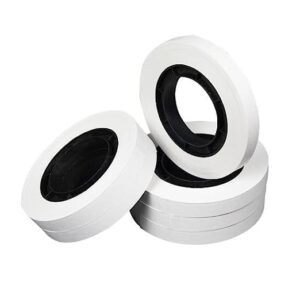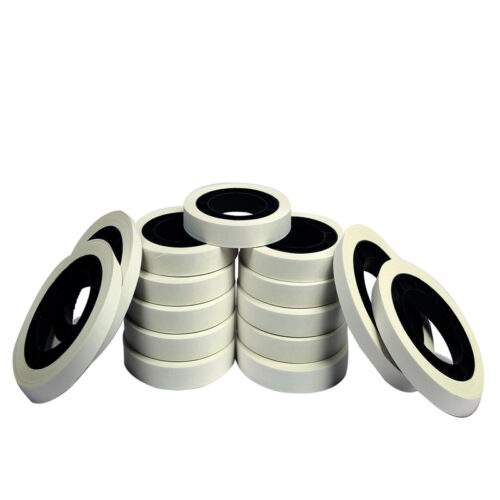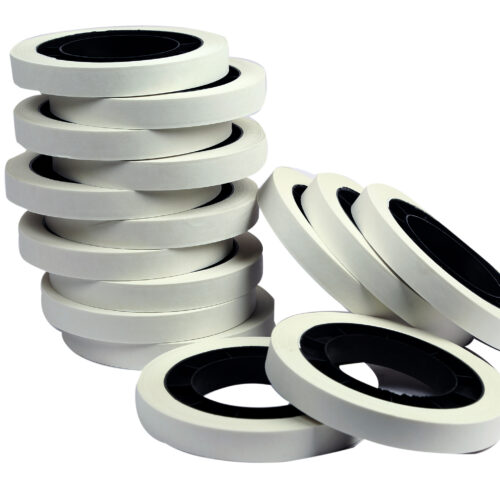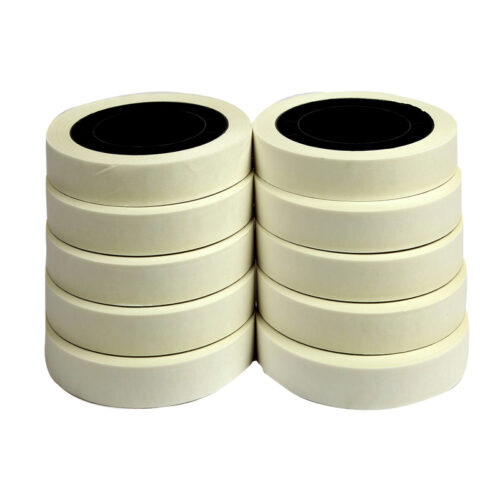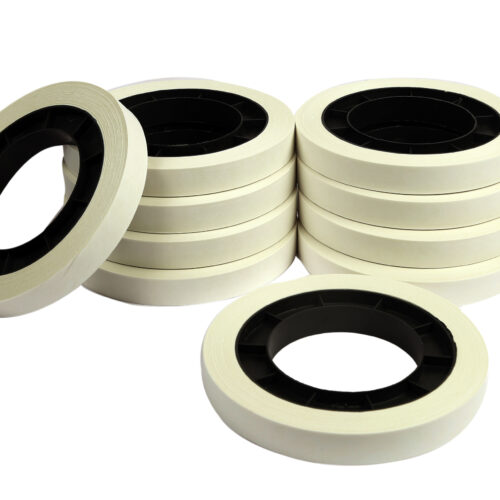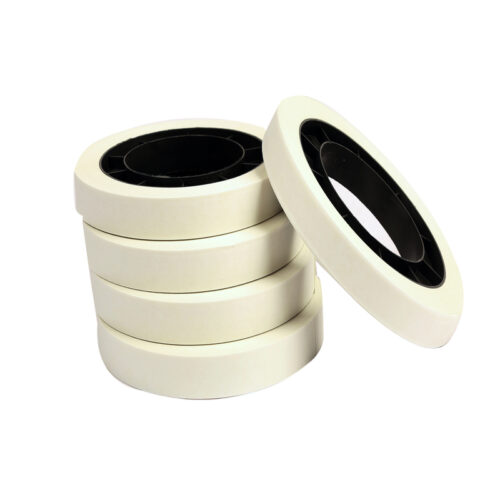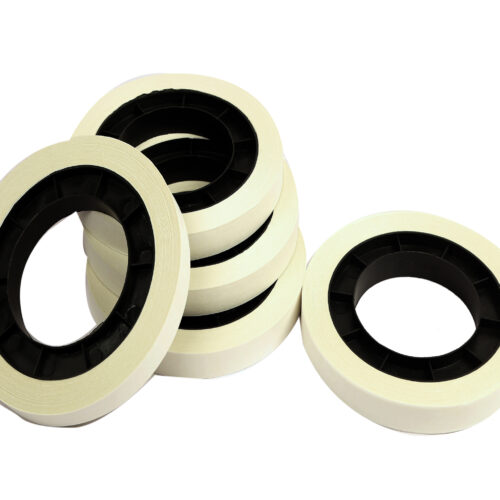Note Binding Tape Roll
Note Binding Paper Tape Roll is a consumable material used in note binding machines to securely bundle and fasten banknotes or currency together. This tape roll is typically made from durable paper material and is designed to withstand the rigors of currency bundling. It is available in various widths to accommodate different stack sizes of banknotes.
Key features of Note Binding Paper Tape Roll
- Durability: The paper used in these rolls is durable enough to withstand the stress of binding multiple banknotes without tearing or breaking easily.
- Security: Note binding tape is often tamper-evident, which means it provides a level of security by showing clear signs of tampering if someone tries to remove or alter the binding.
- Ease of Use: It’s designed to be compatible with note binding machines, ensuring smooth and efficient operation during the binding process.
- Various Sizes: Note binding paper tape rolls are available in different widths to accommodate varying quantities of banknotes.
- Colour Options: Some rolls come in different colours, allowing for easy organization and identification of bundles.
- Adhesive: The tape usually has adhesive properties that, when activated, securely bind the banknotes together.
To use note binding paper tape rolls, you typically load them into a note binding machine, which automatically wraps the tape around a stack of banknotes, creating a secure bundle. This is commonly used in banks, financial institutions, and businesses that handle large quantities of cash for a neat and organized presentation of currency bundles.
A Note Binding Paper Tape Roll is an essential consumable used in conjunction with a note binding machine to securely bundle and fasten banknotes or currency together. These rolls are specifically designed for use with note binding machines and play a crucial role in organizing and maintaining the integrity of cash stacks, particularly in financial institutions, banks, businesses, and currency handling services.
Here’s how the process typically works with a note binding machine:
- Loading the Roll: Begin by loading the appropriate Note Binding Paper Tape Roll into your note binding machine. The roll is placed in a designated compartment or holder within the machine.
- Stacking Banknotes: Arrange the banknotes you want to bundle neatly into a stack. Depending on the capacity of the machine and the width of the tape, you can bundle varying quantities of banknotes.
- Activating the Machine: Start the note binding machine, following the manufacturer’s instructions. The machine will automatically wrap the paper tape securely around the stack of banknotes.
- Securing the Bundle: The paper tape typically has adhesive properties that activate when it’s applied. As the machine wraps the tape around the stack, it adheres to itself, securing the bundle.
- Trimming: Some note binding machines may have a trimming mechanism that cuts the tape to the desired length, ensuring a neat and professional finish.
- Final Bundle: Once the process is complete, you’ll have a tightly bound bundle of banknotes with the Note Binding Paper Tape securely holding them together.
Benefits of using Note Binding Paper Tape and a binding machine include enhanced organization, easy handling of currency bundles, and a professional appearance when dealing with cash transactions. These systems also provide a level of security, as any tampering with the tape would be evident.
In conclusion, Note Binding Paper Tape Rolls, when used in conjunction with note binding machines, serve as an indispensable tool for securely bundling and organizing banknotes or currency. These rolls are designed for efficiency and professionalism, particularly in settings such as banks, financial institutions, and businesses that handle large volumes of cash.
In summary, the combination of Note Binding Paper Tape Rolls and note binding machines simplifies the task of organizing and securing currency, making it an indispensable tool in financial settings and businesses that handle cash.
-
Note Binding Paper Tape Roll Set – 15 Rolls with Various Sizes
GTIN 07AZHPK9910B1ZI Original price was: ₹5400.₹2550Current price is: ₹2550.Buy NowAdd to CartKavinstar Heavy Quality Currency Note Binding Tape 21M (1
Packet 15 Rolls)– Product Type: Note Binding Paper Tape Roll Set
– Set Content: 15 Rolls with Various Sizes
– Suitable for: Note binding
– Ideal For: Banks, businesses, financial institutions, currency handling services
– Versatile Usage: The Note Binding Paper Tape Roll Set offers versatile bundling solutions, accommodating different quantities of banknotes.
– Professional Presentation: Enhance the professional appearance of your bundled banknotes with the neat and secure binding provided by this tape set. -
Banknote Strapping Paper Tape – Set of 10 Rolls (Sizes: 20mm, 25mm, 30mm, 40mm)
GTIN 07AZHPK9910B1ZI Original price was: ₹3600.₹1750Current price is: ₹1750.Buy NowAdd to CartKavinstar Heavy Quality Currency Note Binding Tape 21M (1
Packet 10 Rolls)– Product Type: Banknote Strapping Paper Tape
– Set Content: 10 Rolls (20mm, 25mm, 30mm, 40mm)
– Suitable for: Note banding, currency handling, banknotes
– Price: Rs175 per roll
– Ideal For: Banks, businesses, financial institutions, currency handling services Enhance your note banding and currency handling with the BankNote Strapping Paper Tape set. Its diverse range of sizes, secure binding capabilities, and versatile applications make it an essential tool for maintaining organized and secure currency management. Choose this tape set to streamline your currency handling processes with confidence.
-
Bank Note Binding Tape – Set of 5 Rolls (Sizes: 20mm, 25mm, 30mm, 40mm)
GTIN N/A Original price was: ₹1600.₹910Current price is: ₹910.Buy NowAdd to CartKavinstar Heavy Quality Currency Note Binding Tape 21M
(1 Packet 5 Rolls)Product Specifications:
– Product Type: Bank Note Binding Tape
– Set Content: 5 Rolls (20mm, 25mm, 30mm, 40mm)
– Price: Rs182 per roll
– Suitable for: Currency bundling, banknotes, currency handling
– Ideal For: Banks, financial institutions, businesses, currency handling services Elevate your currency bundling process with the Bank Note Binding Tape set. Its versatile sizes, durable quality, and cost-effective pricing make it a valuable asset for ensuring secure and

